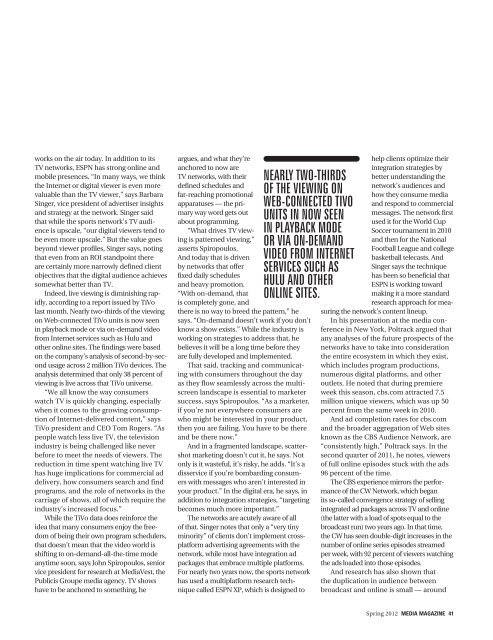THIRD ANNUAL SCREENS ISSUE - MediaPost
THIRD ANNUAL SCREENS ISSUE - MediaPost
THIRD ANNUAL SCREENS ISSUE - MediaPost
You also want an ePaper? Increase the reach of your titles
YUMPU automatically turns print PDFs into web optimized ePapers that Google loves.
works on the air today. In addition to its<br />
TV networks, ESPN has strong online and<br />
mobile presences. “In many ways, we think<br />
the Internet or digital viewer is even more<br />
valuable than the TV viewer,” says Barbara<br />
Singer, vice president of advertiser insights<br />
and strategy at the network. Singer said<br />
that while the sports network’s TV audience<br />
is upscale, “our digital viewers tend to<br />
be even more upscale.” But the value goes<br />
beyond viewer profiles, Singer says, noting<br />
that even from an ROI standpoint there<br />
are certainly more narrowly defined client<br />
objectives that the digital audience achieves<br />
somewhat better than TV.<br />
Indeed, live viewing is diminishing rapidly,<br />
according to a report issued by TiVo<br />
last month. Nearly two-thirds of the viewing<br />
on Web-connected TiVo units is now seen<br />
in playback mode or via on-demand video<br />
from Internet services such as Hulu and<br />
other online sites. The findings were based<br />
on the company’s analysis of second-by-second<br />
usage across 2 million TiVo devices. The<br />
analysis determined that only 38 percent of<br />
viewing is live across that TiVo universe.<br />
“We all know the way consumers<br />
watch TV is quickly changing, especially<br />
when it comes to the growing consumption<br />
of Internet-delivered content,” says<br />
TiVo president and CEO Tom Rogers. “As<br />
people watch less live TV, the television<br />
industry is being challenged like never<br />
before to meet the needs of viewers. The<br />
reduction in time spent watching live TV<br />
has huge implications for commercial ad<br />
delivery, how consumers search and find<br />
programs, and the role of networks in the<br />
carriage of shows, all of which require the<br />
industry’s increased focus.”<br />
While the TiVo data does reinforce the<br />
idea that many consumers enjoy the freedom<br />
of being their own program schedulers,<br />
that doesn’t mean that the video world is<br />
shifting to on-demand-all-the-time mode<br />
anytime soon, says John Spiropoulos, senior<br />
vice president for research at MediaVest, the<br />
Publicis Groupe media agency. TV shows<br />
have to be anchored to something, he<br />
argues, and what they’re<br />
anchored to now are<br />
TV networks, with their<br />
defined schedules and<br />
far-reaching promotional<br />
apparatuses — the primary<br />
way word gets out<br />
about programming.<br />
“What drives TV viewing<br />
is patterned viewing,”<br />
asserts Spiropoulos.<br />
And today that is driven<br />
by networks that offer<br />
fixed daily schedules<br />
and heavy promotion.<br />
“With on-demand, that<br />
is completely gone, and<br />
there is no way to breed the pattern,” he<br />
says. “On-demand doesn’t work if you don’t<br />
know a show exists.” While the industry is<br />
working on strategies to address that, he<br />
believes it will be a long time before they<br />
are fully developed and implemented.<br />
That said, tracking and communicating<br />
with consumers throughout the day<br />
as they flow seamlessly across the multiscreen<br />
landscape is essential to marketer<br />
success, says Spiropoulos. “As a marketer,<br />
if you’re not everywhere consumers are<br />
who might be interested in your product,<br />
then you are failing. You have to be there<br />
and be there now.”<br />
And in a fragmented landscape, scattershot<br />
marketing doesn’t cut it, he says. Not<br />
only is it wasteful, it’s risky, he adds. “It’s a<br />
disservice if you’re bombarding consumers<br />
with messages who aren’t interested in<br />
your product.” In the digital era, he says, in<br />
addition to integration strategies, “targeting<br />
becomes much more important.”<br />
The networks are acutely aware of all<br />
of that. Singer notes that only a “very tiny<br />
minority” of clients don’t implement crossplatform<br />
advertising agreements with the<br />
network, while most have integration ad<br />
packages that embrace multiple platforms.<br />
For nearly two years now, the sports network<br />
has used a multiplatform research technique<br />
called ESPN XP, which is designed to<br />
NEARLY TWO-<strong>THIRD</strong>S<br />
OF THE VIEWING ON<br />
WEB-CONNECTED TIVO<br />
UNITS IN NOW SEEN<br />
IN PLAYBACK MODE<br />
OR VIA ON-DEMAND<br />
VIDEO FROM INTERNET<br />
SERVICES SUCH AS<br />
HULU AND OTHER<br />
ONLINE SITES.<br />
help clients optimize their<br />
integration strategies by<br />
better understanding the<br />
network’s audiences and<br />
how they consume media<br />
and respond to commercial<br />
messages. The network first<br />
used it for the World Cup<br />
Soccer tournament in 2010<br />
and then for the National<br />
Football League and college<br />
basketball telecasts. And<br />
Singer says the technique<br />
has been so beneficial that<br />
ESPN is working toward<br />
making it a more standard<br />
research approach for measuring<br />
the network’s content lineup.<br />
In his presentation at the media conference<br />
in New York, Poltrack argued that<br />
any analyses of the future prospects of the<br />
networks have to take into consideration<br />
the entire ecosystem in which they exist,<br />
which includes program productions,<br />
numerous digital platforms, and other<br />
outlets. He noted that during premiere<br />
week this season, cbs.com attracted 7.5<br />
million unique viewers, which was up 50<br />
percent from the same week in 2010.<br />
And ad completion rates for cbs.com<br />
and the broader aggregation of Web sites<br />
known as the CBS Audience Network, are<br />
“consistently high,” Poltrack says. In the<br />
second quarter of 2011, he notes, viewers<br />
of full online episodes stuck with the ads<br />
96 percent of the time.<br />
The CBS experience mirrors the performance<br />
of the CW Network, which began<br />
its so-called convergence strategy of selling<br />
integrated ad packages across TV and online<br />
(the latter with a load of spots equal to the<br />
broadcast run) two years ago. In that time,<br />
the CW has seen double-digit increases in the<br />
number of online series episodes streamed<br />
per week, with 92 percent of viewers watching<br />
the ads loaded into those episodes.<br />
And research has also shown that<br />
the duplication in audience between<br />
broadcast and online is small — around<br />
Spring 2012 MEDIA MAGAZINE 41








